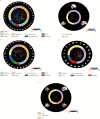State-Dependent Functional Dysconnectivity in Youth With Psychosis Spectrum Symptoms
- PMID: 31219595
- PMCID: PMC7442416
- DOI: 10.1093/schbul/sbz052
State-Dependent Functional Dysconnectivity in Youth With Psychosis Spectrum Symptoms
Abstract
Psychosis spectrum disorders are conceptualized as neurodevelopmental disorders accompanied by disruption of large-scale functional brain networks. Dynamic functional dysconnectivity has been described in patients with schizophrenia and in help-seeking individuals at clinical high risk for psychosis. Less is known, about developmental aspects of dynamic functional network connectivity (dFNC) associated with psychotic symptoms (PS) in the general population. Here, we investigate resting state functional magnetic resonance imaging data using established dFNC methods in the Philadelphia Neurodevelopmental Cohort (ages 8-22 years), including 129 participants experiencing PS and 452 participants without PS (non-PS). Functional networks were identified using group spatial independent component analysis. A sliding window approach and k-means clustering were applied to covariance matrices of all functional networks to identify recurring whole-brain connectivity states. PS-associated dysconnectivity of default mode, salience, and executive networks occurred only in a few states, whereas dysconnectivity in the sensorimotor and visual systems in PS youth was more pervasive, observed across multiple states. This study provides new evidence that disruptions of dFNC are present even at the less severe end of the psychosis continuum in youth, complementing previous work on help-seeking and clinically diagnosed cohorts that represent the more severe end of this spectrum.
Keywords: adolescence; dynamic functional network connectivity; independent component analysis; psychosis spectrum.
© The Author(s) 2019. Published by Oxford University Press on behalf of the Maryland Psychiatric Research Center.
Figures




References
-
- Guloksuz S, van Os J. The slow death of the concept of schizophrenia and the painful birth of the psychosis spectrum. Psychol Med. 2018;48(2):229–244. - PubMed
-
- Poulton R, Caspi A, Moffitt TE, Cannon M, Murray R, Harrington H. Children’s self-reported psychotic symptoms and adult schizophreniform disorder: a 15-year longitudinal study. Arch Gen Psychiatry. 2000;57(11):1053–1058. - PubMed
-
- Linscott RJ, van Os J. An updated and conservative systematic review and meta-analysis of epidemiological evidence on psychotic experiences in children and adults: on the pathway from proneness to persistence to dimensional expression across mental disorders. Psychol Med. 2013;43(6):1133–1149. - PubMed

